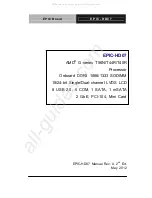
5.2
Peripheral Clocking Considerations
5.2.1 Video Processing Back End Clocking
5.2.2 USB Clocking
www.ti.com
Peripheral Clocking Considerations
The Video Processing Back End (VPBE) is a sub-module of the Video Processing Subsystem (VPSS).
The VPBE is designed to interface with a variety of LCDs and an internal DAC module. There are two
asynchronous clock domains in the VPBE: an internal clock domain and an external clock domain. The
internal clock domain is driven by the VPSS clock (PLL1 SYSCLK4). The external clock domain is
configurable; you can select one of five sources:
•
24 MHz crystal input at MXI1
•
27 MHz crystal input at MXI2 (optional feature)
•
PLL1 SYSCLK3
•
EXTCLK pin (external VPBE clock input pin)
•
PCLK pin (VPFE pixel clock input pin)
For complete information on VPBE clocking, see the
TMS320DM335 Digital Media System-on-Chip
(DMSoC) Video Processing Back End (VPBE) Reference Guide
).
The USB Controller is driven by two clocks: an output clock of PLL1 and an output clock of the USB Phy.
The USB Phy clock is configurable by the USB Phy clock source bits (PHYCLKSRC) in the USB Phy
control register (USB_PHY_CTL) in the System Control Module. USBPHY_CTL is described in
When a 24-MHz crystal is used at MXI1/MXO1, set PHYCLKSRC to 0. This will present a 24-MHz clock to
the USB Phy. When a 36-MHz crystal is used at MXI1/MXO1, set PHYCLKSRC to 1. This will present a
12-MHz (36 MHz divided by three) crystal to the USB Phy. The USB Phy is capable of accepting only 24
MHz and 12 MHz; thus for USB support you must use either a 24-MHz or 36-MHz crystal at MXI1/MXO1.
For more information, see the
TMS320DM335 Digital Media System-on-Chip (DMSoC) Universal Serial
Bus (USB) Controller Reference Guide
SPRUFX7 – July 2008
Device Clocking
37




































